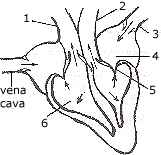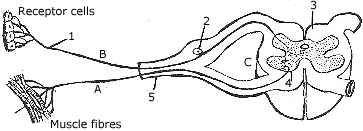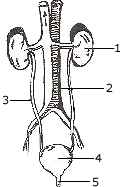(Biology) ICSE Class X Important Questions : Biology (2001)
Disclaimer: This website is NOT associated with CBSE, for official website of CBSE visit - www.cbse.gov.in
Paper : ICSE Class X Important Questions : Biology (2001)
General Instructions
-
The question paper is divided into two Sections.
-
Section I contains one question with five parts (a) to (e); all five parts are to be answered.
-
Section II contains six questions numbered 2 to 7. You are to answer any four of these questions.
-
The intended marks for questions or parts of questions are given in brackets.
SECTION I (40
Marks)
Compulsory: Answer all parts from this Section.
Question 1
(a) Name the following:- [8]
-
The plastid found in the cells of yellow coloured petals.
-
The scientific study of human population.
-
The hormone secreted by beta-cells of islets of Langerhans.
-
The energy currency of a cell.
-
The part of the brain which is concerned with memory.
-
The process by which living organisms obtain energy for their life activities.
-
Chemical substances obtained from certain micro-organisms that destroy harmful microbes.
-
A cytoplasmic organelle found only in an animal cell.
(b) Complete the following statements by filling in the blanks with the appropriate word from the choices given in brackets. You must rewrite the complete statement. [8]
-
The site of light reaction in the cells of a leaf is _______.
(grana, cytoplasm, stroma) -
The part of the cell associated with heredity is _______.
(centrosome, chromosome, nucleolus) -
The chemical substance used to test the presence of starch in the cell of a leaf is _______.
(cobalt chloride, iodine, Benedict’s solution) -
The blood vessel that begins and ends in capillaries is the _______.
(hepatic artery, hepatic portal vein, hepatic vein) -
The site of fertilization in the human female is _______.
(vagina, oviduct, uterus) -
The pulse beat per minute of a normal human adult is _______.
(72, 82, 78) -
Region in the eye where the rods and cones are located is the _______.
(retina, comea, choroid) -
The kind of cells that constitute the cortex of a root are _______.
(collenchyma, parenchyma, sclerenchyma)
(c) Mention where, in living organisms, are the following located and state their main function:- [10]
-
Sebaceous gland.
-
Rhizobium.
-
Ear ossicles.
-
Fovea.
-
Guard cells.
(d) Match the statements given in Column I with the appropriate term from the options given in the box below. You must rewrite the statement given under Column I along with the choice made by you from the options.
|
Red Cross, Malaria, Ribosomes, Adrenal, Exosmosis, Pleural membrane, Carbon monoxide, Measles, World Health Organization, Mitochondria, Liver, Endosmosis, Meninges, Sulphur dioxide. |
Column I [8]
-
Caused by a virus.
-
Concerned with synthesis of protein in a cell.
-
An endocrine gland.
-
Promotes medical education and training.
-
Process by which water enters the root hair cell.
-
Protective covering of the brain.
-
Causes acid rain.
-
Responsible for arranging blood donation camps.
(e) Given below are sets of five
terms. In each case rewrite the terms in the correct order so as to be in
logical sequence. One has been done for you.
Eg. : arterioles, vein, artery, capillaries, vennules.
Ans. : Artery arterioles capillaries → vennules →
vein. [6]
-
organ, cell, protoplasm, system, tissue.
-
afferent arteriole, renal vein, capillary network, glomerules, efferent arteriole.
-
implantation, ovulation, childbirth, gestation, fertilisation.
-
cochlea, tympanum, pinna, auditory canal, ear ossicles.
-
sperm duct, penis, testis, sperms, semen.
-
water molecules, oxygen, grana, hydrogen and hydroxyl ions, photons.
SECTION II
(40 Marks)
Attempt any four questions from this Section.
Question 2
(a) The diagram given below represents the human heart in one phase of its
activity. Study the same and then answer the questions that follow: [6]

-
Name the phase.
-
Which parts of the heart are contracting in this phase? Give a reason to support your answer.
-
Name the parts numbered l to 6.
-
What type of blood flows through the parts marked '1' and '2'?
-
(v) How many valves are closed in this phase?
(b) Potato cubes l cm3 in size were placed in two containers, one containing water, the other containing concentrated sugar solution. After about 24 hours when the cubes were examined, those placed in water were found to be firm and had increased in size by a few millimetres. Those placed in concentrated sugar solution were found to be soft and had decreased in size. Use the above information to answer the questions that follow:- [4]
-
Account for the firmness and increase in size of the potato cubes which were placed in water.
-
Account for the softness and decrease in size of the potato cubes which were placed in the sugar solution.
-
Name and define the physical process being investigated in this experiment.
Question 3
(a) [6]
-
Draw a neat labelled diagram of the experimental set up to show that green plants give out oxygen during photosynthesis.
-
Give the overall chemical equation to represent the process of photosynthesis.
-
Mention two ways in which photosynthesis differs from respiration in plants.
(b) [4]
-
Name two gases that are common air pollutants and state an effect that it has on human health when associated with each.
-
What is meant by 'population density'? What is the operation made in women to prevent the flow of eggs into the oviduct?
-
What do you understand by the term endothermal?
Question 4
(a) The diagram given below shows the internal structure of the spinal cord,
depicting a simple reflex. Study the same and then answer the questions that
follow:- [6]

-
Name the parts numbered 1 to 5.
-
Using the letters of the alphabet shown in the figure, indicate the direction in which an impulse enters and leaves the spinal cord.
-
What is the term given to the point of contact between two nerve cells?
-
What is meant by 'simple reflex'? Give two examples of simple reflexes, and name the stimuli too.
-
How does the arrangement of nerve cells in the spinal cord differ from that in the brain?
(b) [4]
-
Define transpiration.
-
List any two advantages of transpiration to a plant.
-
Briefly explain how the rate of transpiration is affected by:-
a. intensity of light,
b. humidity of the atmosphere.
Question 5
(a) [6]
-
Draw a neat labelled diagram to show the Metaphase stage of Mitosis in an animal cell having '6' chromosomes.
-
How many daughter cells are formed at the end of mitosis and at the end of meiosis?
-
With reference to cell division explain the following terms:-
Chromatid, Centromere, Haploid. -
Name the type of cell division that occurs during:-
a. growth of shoot,
b. formation of pollen grains,
c. repair of worn out tissues.
(b) Complete the following table by filling in the blanks numbered l to 8. [4]
|
Gland |
Hormone Secreted |
Effect on Body |
|
1 |
2 |
Regulates basal metabolism |
|
Pancreas (β cells) |
3 |
4 |
|
5 |
6 |
Increases heart beat |
|
7 |
Thyroid stimulating hormone |
8 |
Question 6
(a) Given below is the figure of certain organs and associated parts in the
human body. Study the same and then answer the questions that follow:- [6]

-
Name all the organ systems shown completely or even partially.
-
Name the parts numbered l to 5.
-
Name the structural and functional unit of the part marked '1'.
-
Name the two main organic constituents of the fluid that flows down the part labelled '3'.
-
Name the two major steps involved in the formation of the fluid that passes down the part labelled '3'.
(b) Define the following terms and in each case give one example:- [4]
-
Pollutant.
-
Antiseptic.
-
Biofertilisers.
-
Vaccine.
Question 7
(a) With regard to the respiratory system and the process of respiration in man,
answer the following questions:- [6]
-
Name the two muscles that help in respiration.
-
Briefly describe how the above mentioned muscles help in the inspiration of air.
-
Give the overall chemical equation to represent the process of respiration in man.
-
What is meant by:-
a. Residual air?
b. Dead air space?
(b) Answer the following briefly:- [4]
-
Why are veins provided with valves?
-
Why does one usually feel dizzy at high altitudes?
-
Plants growing in fertilized soil are often found to wilt if the soil is not adequately watered. Why?
-
How can an animal cell be distinguished from a plant cell?